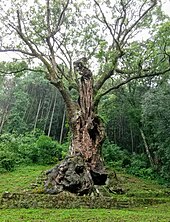Usuario:Alfonso Márquez/probas

Os kami non se consideran metafísicamente diferentes da humanidade,[1] sendo posible que os humanos se convertan en kami[2] Ás veces venérase aos humanos mortos como kami, considerándoos figuras protectoras ou ancestrais[3] Un dos exemplos máis destacados é o do emperador Ōjin, que á súa morte foi consagrado como o kami. Hachiman, considerado protector de Xapón e kami da guerra.[4] In Japanese culture, ancestors can be viewed as a form of kami.[5] In Western Japan, the term jigami is used to describe the enshrined kami of a village founder.[6] In some cases, living human beings were also viewed as kami;[7] these were called akitsumi kami[8] or arahito-gami.[9] In the State Shinto system of the Meiji era, the emperor of Japan was declared to be a kami,[2] while several Shinto sects have also viewed their leaders as living kami.[2]
- ↑ Boyd & Williams 2005, p. 35.
- ↑ 2,0 2,1 2,2 Earhart 2004, p. 8.
- ↑ Littleton 2002, p. 27; Cali & Dougill 2013, p. 13; Hardacre 2017, p. 1.
- ↑ Littleton 2002, pp. 31-32; Cali & Dougill 2013, p. 14.
- ↑ Earhart 2004, p. 10.
- ↑ Bocking 1997, p. 69.
- ↑ Cali & Dougill 2013, p. 13.
- ↑ Picken 2011, pp. 35–36.
- ↑ Picken 2011, p. 42.
